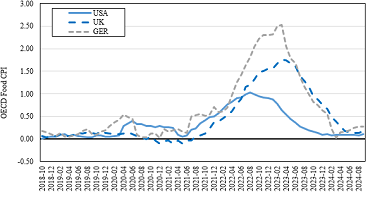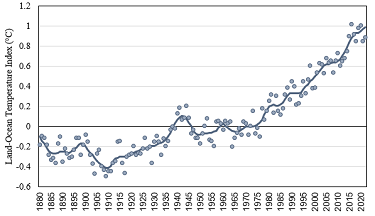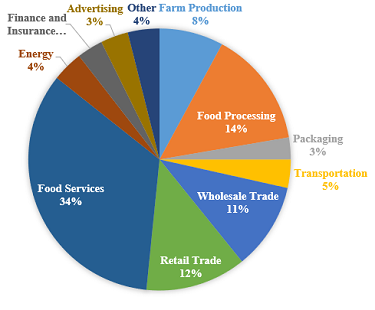
Food price inflation remains a hotly debated topic among pundits, policy makers, and academics around the world, with some commentators identifying rising grocery prices as a decisive factor in recent elections in the United States, the United Kingdom, Italy, Argentina, and Pakistan (Horsley, 2024). In discussing potential drivers of food price inflation, many experts and writers in prominent media outlets—such as The New York Times, The Wall Street Journal, and PBS—have pointed to climate change as a culprit (Popovich, 2022; Kantchev and Chopping, 2023; Nawaz, 2022).
Are these claims about the relationship between climate change and food prices justified? Crucially, the answer to this question depends on what type of climate change is under consideration—past changes versus the various potential future climate change scenarios. Figure 1 highlights the various impact pathways through which climate change may affect food prices. Figure 2 shows recent food inflation trends in the United States, Great Britain, and Germany, while Figure 3 shows global temperature trends. We turn to the academic literature to investigate the potential magnitude associated with these relationships.
As a jumping-off point, it is useful to understand the various cost components that collectively form the price of food that consumers see at the grocery store. According to the USDA, five industries along the value chain constitute the largest cost components in the United States and other high-income countries (USDA-ERS, 2024a):
Together, these five industries represent approximately 80% of the food dollar (Figure 2). Thus, a good way to gauge the extent to which climate change affects consumer food prices is to assess the extent to which climate change affects costs at each of these points separately. After examining the potential magnitude ofthese impacts, we consider the collective implications for the price of food.

There is substantial evidence that future climate change may dramatically reduce agricultural yields (Challinor et al., 2014; Wing, De Cian, and Mistry, 2021; Fang et al., 2023). However, estimates of the effect of past warming on today’s yields and prices are typically more modest. For example, Moore and Lobell (2015) find that climate trends from 1989–2009 resulted in a 2.5% decline in European wheat yields. Jägermeyr et al. (2021) simulate how yields respond to various global emissions scenarios and find that an SSP585 scenario (the scenario that most closely matches historical emissions) implies a decrease in global corn yields of less than 5% in 2024 (inferred from Figure 3, panel a.).
So far, the literature suggests that these modest decreases in global yields have not led to large increases in farmgate prices. Li et al. (2022) find that a 1.5°C warming scenario would lead to a 0.7% increase in the global corn price, relative to a 1985-2006 baseline.
There is limited evidence about the effects of observed climate change on the costs associated with food processing. However, there are global estimates of the impacts of future warming on manufacturing more generally, which provide an idea of the relevant magnitudes of this relationship. Nath (2025) estimates country-specific effects of the impact of future warming on manufacturing productivity and reports a net effect of 1.7% on productivity globally but negligible effects for the United States and other high-income regions. Since these estimates are based on estimates of future warming that far exceed observed warming to date, relevant values for today’s inflation debate would be even smaller in magnitude. Moreover, a 1-percentage-point loss in the productivity of food processing would necessarily translate into less-than-1-percentage-point increase in per unit costs.
Of course, one unique feature of the food processing industry that may lead to climate impacts that are larger than for other manufacturing industries is food safety. Most notably in this respect, warmer temperatures or threats to the cold chain induced by extreme weather events can lead to increased microbial growth (Anas et al., 2021). How might food safety issues like this translate into increased food processing costs? To gauge the potential magnitude of these effects, we note that the costs of all food safety incidents are estimated by be $7 billion annually across the food supply chain (Hoffman and Ahn, 2021). This cost represents a little less than 2% of U.S. consumer expenditures that are attributable to food processing. In other words, even if one were to assume that climate change was responsible for a fifth of today’s food safety incidents (almost certainly an egregious overestimation), this impact pathway would still constitute less than 0.5% of the food processing sector’s portion of U.S. food expenditures.

Wholesalers, distributors, and retailers selling perishable items rely heavily on refrigeration. Extreme temperatures may drive up electricity prices, making refrigeration more expensive. Additionally, rising temperatures may cause retailers’ cooling needs to increase. What is the potential magnitude of these effects? A large body of work investigates the effects of temperature on electricity prices. Most recently, Mosquera-López, Uribe, and Joaqui-Barandica (2024) find that in Europe the impactof weather conditions on electricity prices hinges on a country’s initial climatic conditions, generation mix, policies, energy efficiency levels, and behavioral factors. However, in general, the impact of temperature on energy prices is inconsequential until temperature reaches an “extreme” threshold level. For example, in France, when temperatures drop below 0°C, the relationship is amplified. When median daily temperatures fall below this level, the cumulative effect on electricity prices equates to a temporary increase of up to 50%. Of course, these thresholds do not account for long-run adaptation strategies of future climate change.

The majority of food service (restaurant) costs are attributable to labor (USDA-ERS, 2024b). The impact of observed climate change on labor costs is difficult to assess, as it depends not only on the effect of climate changes on workers’ productivity but also on the impact of climate on a complex set of general equilibrium effects that may affect an economy’s labor supply differently across locations. Many of the shifts may offset, as decreases in labor supply in some regions lead to commensurate increases in other regions. An important caveat is that, if climate change increases the disutility of working generally, we would expect climate change to cause an overall contraction of the labor supply, increasing labor costs for food service firms. A recent working paper by Rode et al. (2022) finds potentially large negative effects of future climate change on the global labor supply, with the average worker reducing labor by 5.4 minutes per day by 2099 under an RCP8.5climate scenario. However, this same paper finds near-zero and insignificant effects for the richest quintile of countries, including the United States. Additionally, some cooler, wealthier countries—such as Canada and the United Kingdom—are estimated to see an increase in labor supply from future climate change.
Given these small estimates of future labor contractions due to climate change, the effect of observed climate change on the labor supply for food services is likelysmall, almost certainly representing less than a 1% increase relative to a no-climate-change counterfactual.
Taken together, what do the relationships between climate change and costs at each of these points of the food supply chain imply about the collective implications of climate change on the price of food to date? Based on the above discussion, Table 1 provides some back-of-the-envelope calculations to gauge the relative magnitude of these effects.
Based on a set of conservative assumptions, we posit that past climate change has increased consumer food prices somewhere in the range of 2.2%–6.7% over the last 50 years. By comparison, food prices in U.S. cities have increased 53.1% between January 2010 and the end of 2024 (Federal Reserve Bank of St. Louis, 2025).
Overall, there is limited evidence that observed climate change has significantly increased food prices. However, although climate change has not been a major factor in recent food price increases, its impact on individual agricultural producers remains profound and poses a significant future threat. This is especially true in developing countries, where agriculture is often a dominant economic activity and farmgate prices constitute a larger share of consumers’ food expenditures. And—as a corollary to this discussion—the current easing of inflation is not a sign that climate threats are diminishing. July 2024 was the hottest month on record globally (NCEI, 2024), and current projections indicate that global emissions are likely to lead to over 2°C of warming by mid-century (IPCC, 2021). This level of warming will threaten global food security, even if the current effects of climate change have had a limited impact on food affordability in developed countries.
Anas, M., M.A. Sami, Z. Siddiqui, K. Khatoon, M.T. Zeyad, and A. Malik. 2021. “Impact of Climate Change on the Incidence and Transfer of Food- and Water-Borne Diseases.” In S.A. Lone and A. Malik, eds. Microbiomes and the Global Climate Change. Springer, pp. 123–144. https://doi.org/10.1007/978-981-33-4508-9_9
Baker, Q., and C. Zachary. 2023, December 21. “ERS Food Dollar’s Three Series Show Distributions of U.S. Food Production Costs.” Amber Waves.
Challinor, A., J. Watson, D. Lobell, S. Howden, D. Smith, and N. Chhetri. 2014. “A Meta-Analysis of Crop Yield Under Climate Change and Adaptation.” Nature Climate Change 4:287–291. https://doi.org/10.1038/nclimate2153
Cohen, A. 2024, June 29. “The Trump-Biden Presidential Debate and U.S. Energy Policy.” Forbes. Available online: https://www.forbes.com/sites/arielcohen/2024/06/29/the-trump-biden-presidential-debate-and-us-energy-policy/
Fang, M., S. Jin, K. Deininger, and M. Gammans. 2023. “Heterogenous Climate Impacts on Crop Yields: Evidence from Ukraine.” Environmental Research Communications 5(10):105015. https://doi.org/10.1088/2515-7620/acde36
Federal Reserve Bank of St. Louis. 2025. “Consumer Price Index for All Urban Consumers: Food (CPIUFDSL).” FRED Economic Data. Available online: https://fred.stlouisfed.org/series/CPIUFDSL [Accessed May 16, 2025]
Hoffmann, S., and J.-W. Ahn. 2021, April 2. “Economic Cost of Major Foodborne Illnesses Increased $2 Billion from 2013 to 2018.” Amber Waves.
Horsley, S. 2024, November 12. “Why High Prices Toppled Democrats—and Other Governments around the World.” NPR. Available online: https://www.npr.org/2024/11/12/nx-s1-5186615/high-prices-inflation-economy-election-voters
Hussain, M.A., and C.O. Dawson. 2013. “Economic Impact of Food Safety Outbreaks on Food Businesses.” Foods 2(4):585–589. https://doi.org/10.3390/foods2040585
Intergovernmental Panel on Climate Change (IPCC). 2021. Climate Change 2021: The Physical Science Basis. Contribution of Working Group I to the Sixth Assessment Report of the Intergovernmental Panel on Climate Change. Cambridge University Press.
Jägermeyr, J., C. Müller, A.C. Ruane, J. Elliott, J. Balkovic, O. Castillo, B. Faye, I. Foster, C. Folberth, J. A. Franke, K. Fuchs, J.R. Guarin, J. Heinke, G. Hoogenboom, T. Iizumi, A.K. Jain, D. Kelly, N. Khabarov, S. Lange, T.-S. Lin, W. Liu, O. Mialyk, S. Minoli, E.J. Moyer, M. Okada, M. Phillips, C. Porter, S. S. Rabin, C. Scheer, J.M. Schneider, J.F. Schyns, R. Skalsky, A. Smerald, T. Stella, H. Stephens, H. Webber, F. Zabel, and C. Rosenzweig. 2021. “Climate Impacts on Global Agriculture Emerge Earlier in New Generation of Climate and Crop Models.” Nature Food 2:873–885. https://doi.org/10.1038/s43016-021-00400-y
Kantchev, G., and D. Chopping. 2023, July 24. “Where Heat Waves Lead, Food Inflation Will Follow.” Wall Street Journal. Available online: https://www.wsj.com/articles/where-heat-waves-lead-food-inflation-will-follow-ee6a32c
Li, Y., J. Pan, W. Xiong, W. Xie, and T. Ali. 2022. The Impact of 1.5 C and 2.0 C Global Warming on Global Maize Production and Trade. Scientific Reports, 12(1), 17268. https://doi.org/10.1038/s41598-022-22228-7
Moore, F., and D. Lobell. 2015. “The Fingerprint of Climate Trends on European Crop Yields.” Proceedings of the National Academy of Sciences 112(2):2670–2675. https://doi.org/10.1073/pnas.1409606112
Mosquera-López, S., J.M. Uribe, and O. Joaqui-Barandica. 2024, “Weather Conditions, Climate Change, and the Price of Electricity.” Energy Economics 137: 107789. https://doi.org/10.1016/j.eneco.2024.107789
Nath, I. 2025. “Climate Change, the Food Problem, and the Challenge of Adaptation through Sectoral Reallocation.” Journal of Political Economy 0(0). https://doi.org/10.1086/734725
National Centers for Environmental Information (NCEI). 2024, July. Global climate report - July 2024. National Oceanic and Atmospheric Administration. https://www.ncei.noaa.gov/access/monitoring/monthly-report/global/202407
Nawaz, A. 2022, May 16. “The Major Factors Driving up the Cost of Food.” PBS NewsHour. Available online: https://www.pbs.org/newshour/show/the-major-factors-driving-up-the-cost-of-food
Norland, E. 2022, May 26. “Crop Prices and Inflation: What Is the Relationship?” CME Group. Available online: https://www.cmegroup.com/insights/economic-research/2022/crop-prices-and-inflation-what-is-the-relationship.html
Phillips, M. 2024, August 15. “Kamala Harris Pushes Crackdown on Price Gouging as Inflation Persists.” New York Times. Available online: https://www.nytimes.com/2024/08/15/business/economy/kamala-harris-inflation-price-gouging.html
Popovich, N. 2022, August 9. “How Climate Change Is Fueling Inflation.” New York Times. Available at https://www.nytimes.com/2022/08/09/climate/inflation-climate-change
Rode, A., R.E. Baker, T. Carleton, A. D'Agostino, M. Delgado, T. Foreman, D. R. Gergel, M. Greenstone, T. Houser, S. Hsiang, A. Hultgren, A. Jina, R.E. Kopp, S. B. Malevich, K.E. McCusker, I. Nath, M. Pecenco, J. Rising, and J. Yuan. 2022. “Labor Disutility in a Warmer World: The Impact of Climate Change on the Global Workforce.” SSRN. http://dx.doi.org/10.2139/ssrn.4221478
U.S. Department of Agriculture Economic Research Service (USDA-ERS). 2024a. “Food Dollar Series.” Available online: https://www.ers.usda.gov/data-products/food-dollar-series/
———. 2024b. “Food Service Industry.” Available online: https://www.ers.usda.gov/topics/food-markets-prices/food-service-industry/
Wing, I.S., E. De Cian, and M.N. Mistry. 2021. “Global Vulnerability of Crop Yields to Climate Change.” Journal of Environmental Economics and Management 109:102462. https://doi.org/10.1016/j.jeem.2021.102462